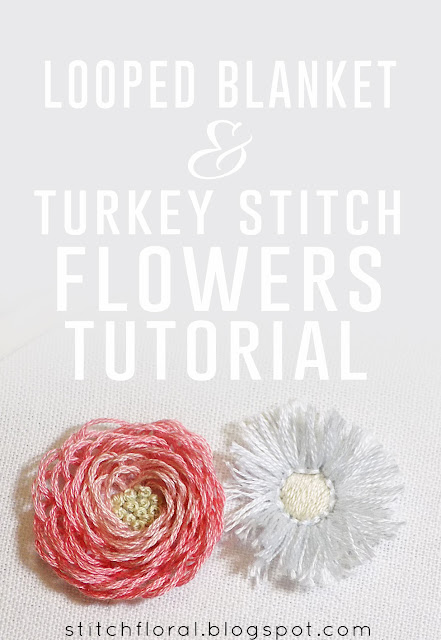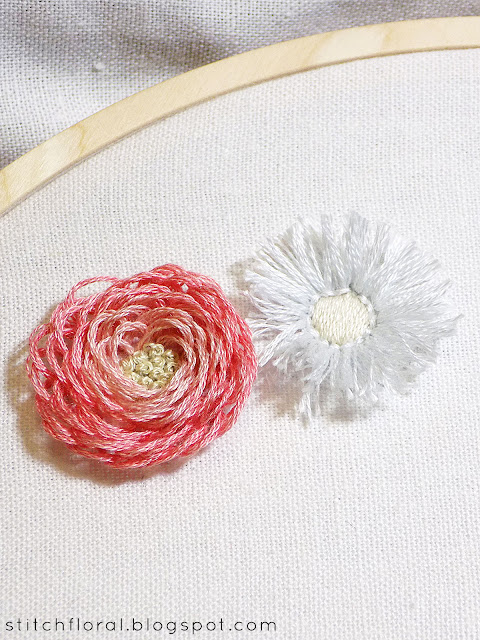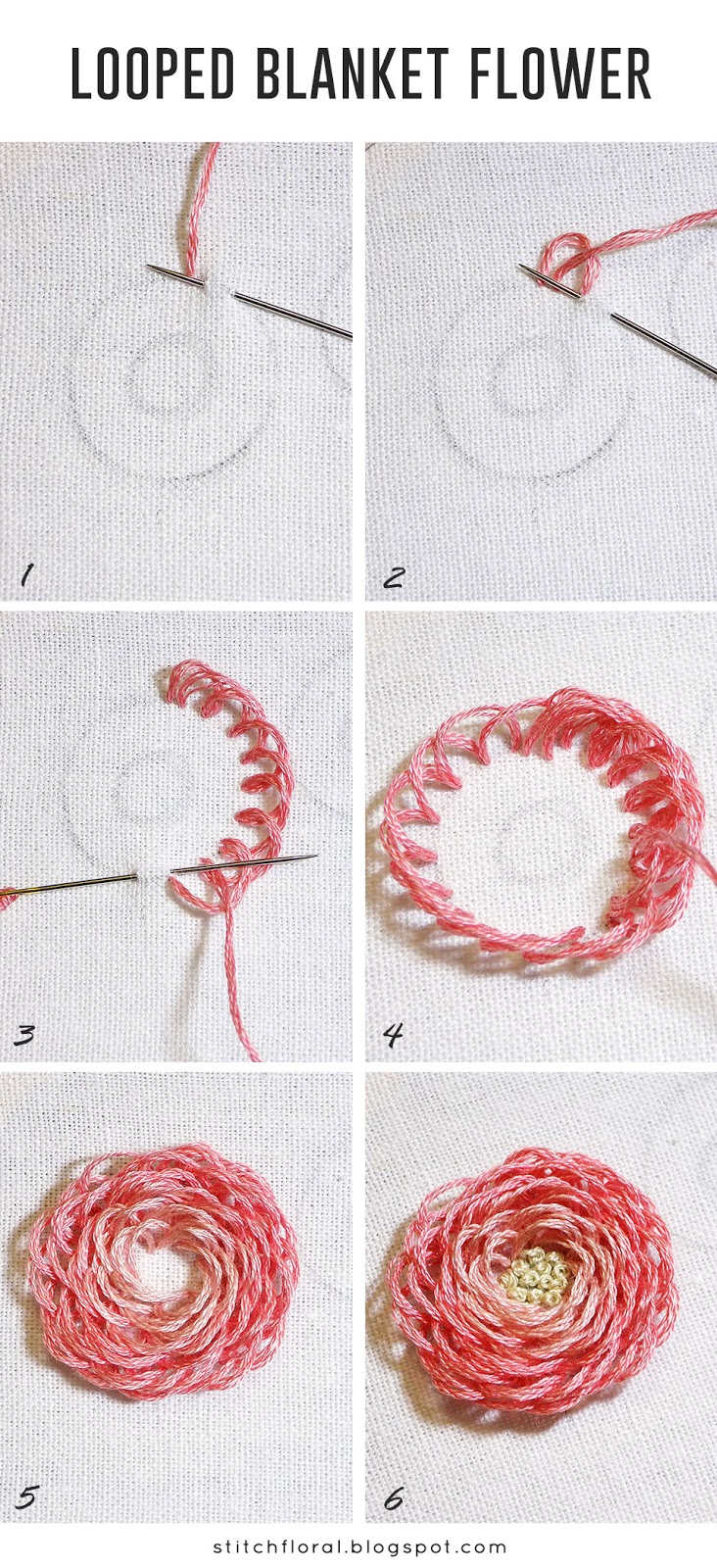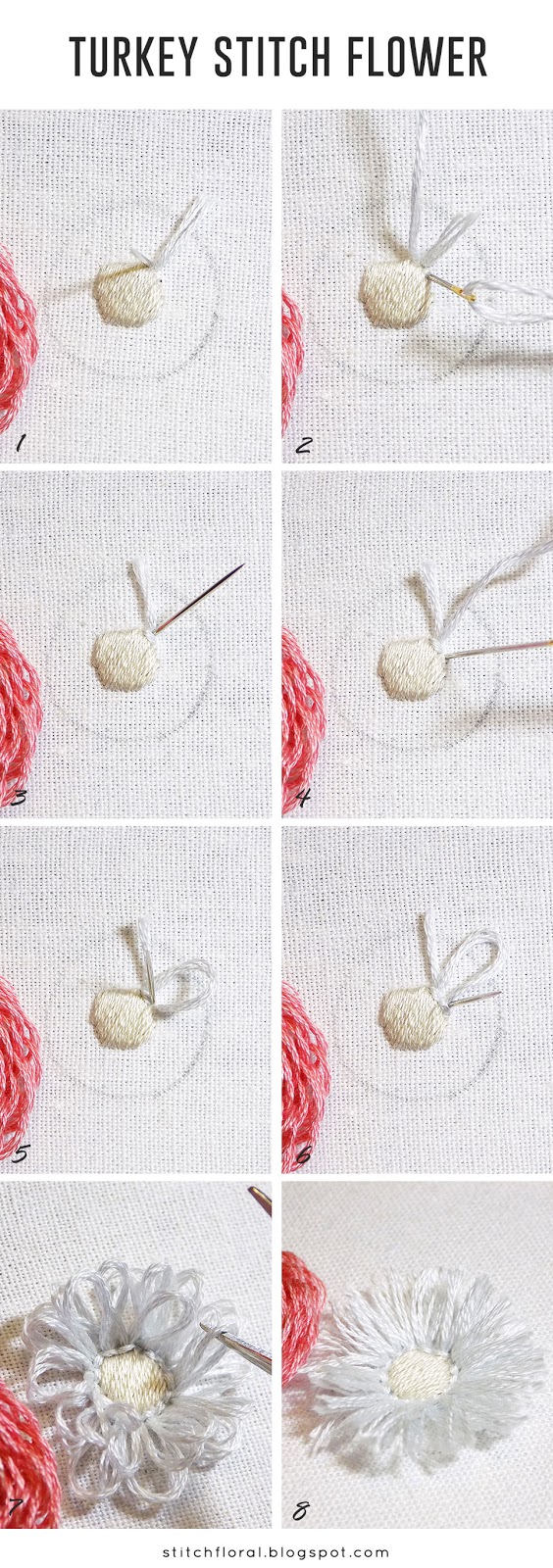Here's another tutorial for embroidered flowers!
Like last time, these flowers are also very easy to stitch so they will fit your project even if you're a beginner. They are both also quite dimensional and realistic – there's a reason why they are used in stumpwork, after all.
So, without further ado, let's jump to the tutorials!
Looped blanket flower
So this flower is basically built out of loops.
1. Bring the needle up through the fabric at any point on the edge of a circle shape. Then insert the needle back into the fabric at a distance of a stitch length (it will decide the width of your loop), bringing it back up in the middle between the two points. Keep in mind, it is better to use all 4-6 strands of floss in the needle (or thick thread) so that the flower turns out dimensional enough. Unless your flower is very small, of course.
2. From there take one more step to the side and insert the needle at distance of stitch length again, bringing it up at the same point where the previous loop ended.
3. Keep repeating the previous steps, creating loops along the edge of the circle.
4. Make extra rows of the looped blanket stitch inside the shape,
5. You can fill the whole shape by the rows of looped blanket stitch, or you can leave some free space for the center of the flower. When the stitches are complete, fluff them up a little with your fingers.
6. In my case, I added french knots to the center.
This is how the finished result will look like.
Ranunculus, anyone? It really reminds me of ranunculus flowers.
By the way, you can play with the color of thread, as well! I used a lighter one for the rows of stitches that are closer to the center.
Turkey stitch flower
Turkey stitch is usually used when you want to have a “rag” effect for some elements in your embroidery. While working it, you also form loops. But they are secured by extra stitches in place, so if you cut the loops the thread won't come out of fabric – it will stay. Unlike with looped blanket stitch where the loops aren't really anchored.
This tutorial has 8 grids, so the site compresses it because of the size. If you open it in a new tab, you will be able to see it in full size.
1. First of all, we don't need to make a knot at the end of the thread. We leave the end as it is. And instead of bringing the needle up through the fabric, we actually, bring the needle down through the fabric. Do that at any point at the edge of the circle shape.
Leave the “tail” of the thread on the surface of the fabric, and bring the needle up to the side of it.
(Also, you might have noticed that I already prepared the center with satin stitch. You can use anything you want for the center: french knots, ribbed spider web, bullion knots, etc. )
2. Make a straight stitch at the base of the thread “tail”. It will help secure it in place.
3. Bring the needle up at the same point where the thread “tail” is situated.
4. And insert the needle into the fabric at a distance of the stitch length. Now we will start forming loops.
5. One “leg” of this loop is already secure by a straight stitch, now we need to do the same with the other “leg”. So the needle emerges at the end of the previous straight stitch to make a new one.
6. Then you bring the needle up again where the previous loop ended. Keep repeating these steps, starting the loops at the same place where the previous ended and securing each leg by straight stitches placed tightly together.
7. You can make as many rows as you want. In this example, I made two rows of stitches. When you deem it enough, cut each loop in half.
8. Then trim the ends and fluff them up :)
Frankly speaking, I'm often content with just loops of turkey stitch, without cutting them, like in step 7. If you relate, then you can start the whole thing a bit differently. Make a knot at the end of the thread, bring it up, make a loop and secure each leg with a straight stitch and keep going in the same way. These loops lie more flat so the result will look different than with the looped blanket.
Also, if you don't like the look of straight stitches around the middle, you can cover them by french knots, haha.
So, how do you like today's flowers? Aren't they pretty? Make sure to use them in your embroidery! :)

















its beautiful. I have never seen them anywhere else!
ReplyDeleteVery pretty, and I love the texture! Are the threads knotted underneath?
ReplyDeleteExcept for when you start and end your thread, there are no extra knots underneath :)
Delete